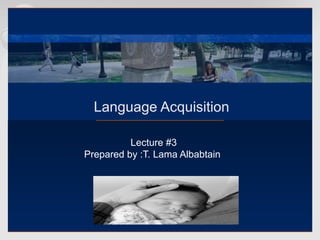
Stages of child language development
- 1. Language Acquisition Lecture #3 Prepared by :T. Lama Albabtain
- 2. Stages of First Language Acquisition Lesson Objectives: 1. Name the main stages of first language acquisition. 2. Explain Pre-speech Stage. 3. Explain Babbling Stage. 4. Explain One word (Holophrastic) Stage. 5. Explain Combining words Stage 2
- 3. The Main Stages Of First Language Acquisition. 1. Pre-speech Stage. 2. Babbling Stage. 3. One word (Holophrastic) Stage. 4. Combining words Stage 3
- 4. 1.Pre-speech stage : infants learn to pay attention to speech, pays attention to intonation and the rhythm of speech long before they begin to speak. Infants respond to speech more keenly than to other sounds. Speech elicits greater electrical activity in the left side of the 2 month old infant's brain than do other sounds. Experiment with microphone and nipple showed that infants suck more vigorously if the action triggers a human voice as opposed to music or other sounds 4
- 5. Infants can distinguish between /p/ and /b/ at three or four months (in an experiment with /ba/ played vs. /pa/, a two month infant showed awareness of the change). But children do not learn how to use these sounds until much later-- around the second year or later 5
- 6. 2. Babbling stage: 6
- 7. 2. Babbling stage: Begins at several months of age 4 to 6 Characterized by indiscriminate utterance of speech sounds-- Many native speech sounds may be absent-- some are naturally harder to pronounce-- /r/ /th/. Very few consonant clusters and repeated syllables are common 7
- 8. 3. One word ( holophrastic ) stage: 8
- 9. 3. One word ( holophrastic ) stage: Infants may utter their first word as early as nine months: usually mama, dada (these words resemble babbling). Deaf babies whose parents use sign language begin making their first word/gestures around eight months. This stage is characterized by the production of actual speech signs. Often the words are simplified: "du" for duck, "ba" for bottle. 9
- 10. When the child has acquired about 50 words he develops regular pronunciation patterns. Children tend to perceive more phonemic contrasts than they are able to produce themselves. 10
- 11. The first 50 words tend to be names of important persons, greetings, foods, highlights of the daily routine such as baths, ability to change their environment-give, take, go, up, down, open. The meaning of words may not correspond to that of adult language: overextension--.. bird may mean any flying object. 11
- 12. dog may mean any four legged creature 12
- 13. apple may mean any round object 13
- 14. bird may mean any flying object. 14
- 15. 4. Combining words stage: 15
- 16. Combining words stage By two and a half years most children speak in sentences of several words--but their grammar is far from complete. This stage rapidly progresses in to what has been termed a fifth and final stage of language acquisition, the All hell breaks loose stage . By six the child's grammar approximates that of adults. Children learning any language seem to encode the same limited set of meanings in their first sentences: ownership-- Daddy's shoes; describing events-- Me fall; locational relations-- toy in box 16
- 17. Sentences usually two words. Children can repeat more complex sentences spoken by adults but cannot create them until later. . The ends of words learned more quickly: -raff for giraff, -mato for tomato, -narna for banana. 17
- 18. The rest of the acquisition of grammar is idiosyncratic-- some children repeat more, others create more. Some children produce a great number of words before beginning to combine them into sentences. Others immediately begin to make sentences . There may be several individual routes to mastering one's native language. 18
- 19. Quiz Mark true or false : 1- Infants can distinguish between /p/ and /b/ in the pre-speech stage . 2- Infants know the difference of phonological patterns . 3- Very few consonant clusters and repeated syllables are common in the babbling stage. 4- Infants may utter their first word in the Holophrastic stage . 5- In the combining words stage, most children speak in sentences of several words 7-The first 6 words tend to be names of important persons, greetings, foods, 19
- 20. For More Information http://quizlet.com/4967917/stages-of-child- language-acquisition-flash-cards/ 20
